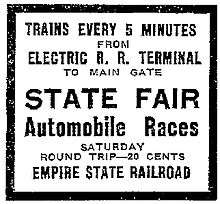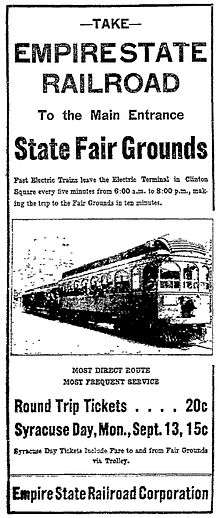Empire State Railway
| Locale | Syracuse, New York to Oswego, New York |
|---|---|
| Dates of operation | 1916–1931 |
| Track gauge | 4 ft 8 1⁄2 in (1,435 mm) standard gauge |
The Empire State Railway, established in 1916, was an interurban rail that ran from Syracuse, New York, to Oswego, New York, a distance of 38 miles (61 km).[1] Streetcar service on the route ran until 1931 when it was abandoned in favor of buses.[2]
History

The Empire State Railway ran from Downtown Syracuse to Oswego, New York, via Baldwinsville, Phoenix and Fulton. The line ran on the beds of the streets in the cities and villages by franchise and on private right-of-way for the remainder.[1]
Empire United Railways
The Empire State Railroad Corporation was formed on October 30, 1916, to take over part of the property of the Empire United Railways, Inc.[3]
The following directors and officers were elected; H. S. Holden, William Nottingham, Harold Tenney, Joshua Backman, J. C. Nelson and Thomas W. Meachem, all of Syracuse and W. H. Lippincott of Philadelphia, C. E. Hotchkiss and F. R. Ford of New York City. H. R. Holden was named president, F. R. Ford was chairman of executive committee, J. C. Nelson was vice-president and general manager, H. J. Clark was treasurer, S. C. Stivers was secretary and comptroller and J. H. Yoder was auditor.[3]
The new company took over the property from the receiver on October 31, 1916. The firm owned the interurban electric railway between Syracuse and Oswego, including the local electric railway system in Oswego and the Syracuse terminal. The Rochester and Syracuse Railroad used the Syracuse terminal under a rental agreement.[3]
The Empire State Railroad Corporation also owned the interurban electric railway extending from Auburn to a connection with the Rochester and Syracuse Railroad at Port Byron, New York, 26 miles (42 km)west of Syracuse. They also owned part of the local electric railway system in Auburn which was operated by the Auburn and Syracuse Electric Railroad. The total track owned by the Empire State Railroad Corporation was 83 miles (134 km), of which 70 miles (110 km) was interurban and 13 miles (21 km) miles city track. Power was supplied by the Niagara, Lockport and Ontario Power Company from Niagara Falls, Salmon River and Oswego River hydro-electric developments.[3]
Union wage agreement

In April 1903, officials of the Empire State Railway and Division 7373, Street Railway Employees, met to discuss a new wage agreement to go into effect the next month. The men were working for 55 cents an hour and asked for an increase to 70 cents an hour.[4]
Company management
On March 9, 1920, J. C. Nelson was elected president of the company at a meeting of the board of directors. He was formerly general manager and vice-president and succeeded the late H. S. Holden, who died in November 1918. Nelson was placed in charge of the company's affairs during the time the president's office was vacant. L. L. Odell, treasurer, was elected assistant general manager.[5]
By April 1927, officers of the company were Alexander H. Cowie, president; Talmadge C. Cherry, vice-president; Mercer V. White, secretary; and Walter K. Zinsmeister, treasurer.[6]
Financial
In June 1920, the total value of the Empire State Railway Corporation franchise in Syracuse as determined by the New York State Tax Commission was $72,000, down from $74,700 in 1919.[7]
Vacation excursions
By May 1923, a round trip to Oswego from Syracuse cost $2.30. The company advertised that "If you have never visited historic Fort Ontario and the modern U.S. Army barracks at Oswego you have missed one of the sights of Central New York. Ontario Beach promises to be more popular this year."[8]
Another round trip to Fulton cost $1.60. Additionally, a daily excursion to Long Branch Park in Liverpool to the Long Branch Amusement Park cost 30 cents. The park was called "the Coney Island of Syracuse.[8]
Tickets were sold at the "Electric Terminal" at 112 West Genesee Street where other rails such as Rochester and Syracuse Railroad and Syracuse Northern Electric Railroad also sold vacation excursions.[8]
Rochester and Syracuse railroad
The Rochester and Syracuse Railroad (R&S) acquired control of the Empire State Railroad in 1922. In 1930, the company leased the Port-Byron-Auburn line after the abandonment of the direct interurban between Syracuse and Auburn, however this was short lived as the entire R&S line was abandoned on June 27, 1931.[9]
The Oswego route of the Empire State Railway was abandoned three days earlier on June 24, 1931.[9]
Bankruptcy
On April 29, 1927, an order for a voluntary dissolution of the Empire State Railroad Corporation, which operated trolleys between Syracuse and Oswego under the name Empire State Railways, was signed by Justice Ernest I. Edgecomb in New York Supreme Court. At that time, trolley services were not affected.[6]
T. C. Cherry, vice-president, was named receiver. He provided a bond of $50,000 to continue operation of the road. The order was returnable and stockholders had until June 25 of 1927 to file their objections to the dissolution of the corporation. The company had been in financial straits for some time.[6]
Land use
By 1974, the bed of this line was occupied by Interstate Route 690 from Syracuse to the New York State Thruway and by a Niagara Mohawk Power Line from the New York State Thruway to Baldwinsville. The area from Baldwinsville to Phoenix ran through the Three Rivers Game Management Area and was occupied by an abandoned natural gas line from a private gas well. Later, the railroad bed was reputedly owned by the various adjoining land owners.[1]
The railroad bed from Phoenix to Fulton was occupied by Niagara Mohawk for a gas line and a power line and the northern 4 miles (6.4 km) contained a private water line that was owned by city of Fulton.[1]
References
- 1 2 3 4 "Inventory of Abandoned Railroad Rights of Way". New York State Department of Transportation, 1974. Retrieved February 18, 2011.
- ↑ "New York Interurbans and Streetcar Railroads". American-rails.com, 2007. Retrieved February 16, 2011.
- 1 2 3 4 Electric railway journal, Volume 50. McGraw-Hill Publishing Company, Inc., December 1917, pg. 1100. Retrieved February 4, 2011.
- ↑ "Empire Carmen and Officials to Meet". Syracuse Herald. Syracuse, New York. April 3, 1922.
- ↑ Electric Railway Journal. New York; McGraw-Hill Company, Inc., June 1920 p.626. Retrieved February 28, 2011.
- 1 2 3 "Receiver Named for Empire State Railway". Syracuse Herald. Syracuse, New York. April 29, 1927.
- ↑ "Few Changes Noted in Values of Franchises". Syracuse Herald. Syracuse, New York. June 18, 1920.
- 1 2 3 "Where to Go Memorial Day". Syracuse Herald. Syracuse, New York. May 29, 1923.
- 1 2 Hilton, George W.; Due, John. The Electric Interurban Railways in America. Stanford University Press, 1960, p.314. Retrieved March 4, 2011.